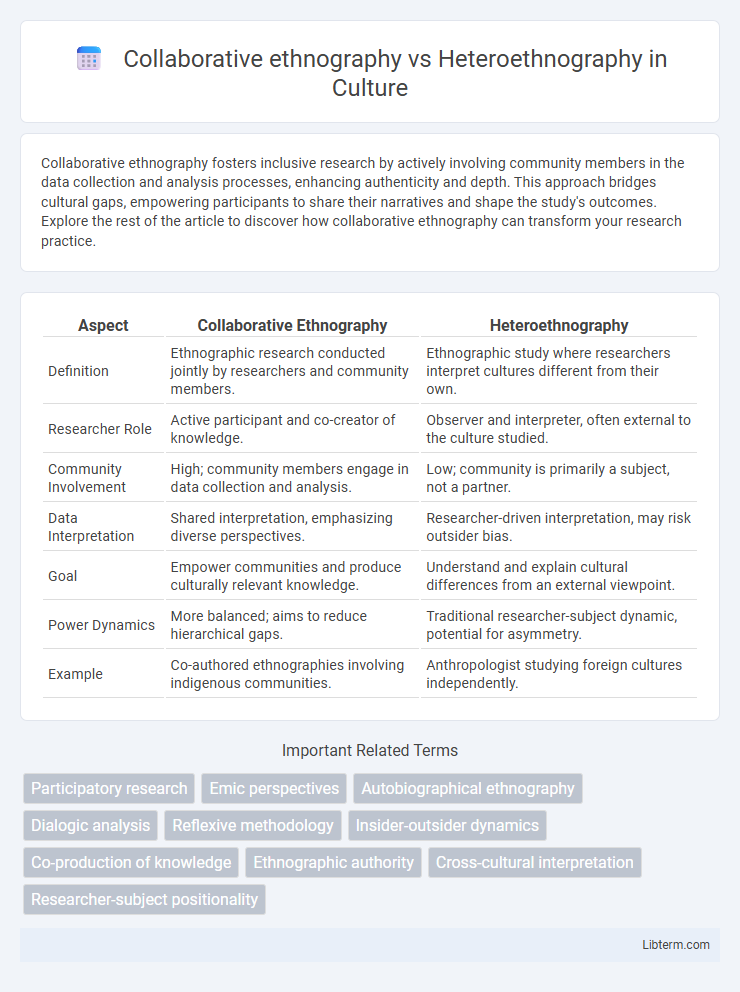Collaborative ethnography fosters inclusive research by actively involving community members in the data collection and analysis processes, enhancing authenticity and depth. This approach bridges cultural gaps, empowering participants to share their narratives and shape the study's outcomes. Explore the rest of the article to discover how collaborative ethnography can transform your research practice.
Table of Comparison
| Aspect | Collaborative Ethnography | Heteroethnography |
|---|---|---|
| Definition | Ethnographic research conducted jointly by researchers and community members. | Ethnographic study where researchers interpret cultures different from their own. |
| Researcher Role | Active participant and co-creator of knowledge. | Observer and interpreter, often external to the culture studied. |
| Community Involvement | High; community members engage in data collection and analysis. | Low; community is primarily a subject, not a partner. |
| Data Interpretation | Shared interpretation, emphasizing diverse perspectives. | Researcher-driven interpretation, may risk outsider bias. |
| Goal | Empower communities and produce culturally relevant knowledge. | Understand and explain cultural differences from an external viewpoint. |
| Power Dynamics | More balanced; aims to reduce hierarchical gaps. | Traditional researcher-subject dynamic, potential for asymmetry. |
| Example | Co-authored ethnographies involving indigenous communities. | Anthropologist studying foreign cultures independently. |
Introduction to Collaborative Ethnography
Collaborative ethnography emphasizes joint research efforts where community members actively participate in data collection, analysis, and interpretation, fostering empowerment and reciprocal knowledge exchange. This approach contrasts with heteroethnography, which typically involves outsider researchers studying communities from an external perspective with limited collaboration. By integrating local voices and expertise, collaborative ethnography enriches cultural understanding and produces more nuanced, context-sensitive insights.
Defining Heteroethnography
Heteroethnography emphasizes interpreting and representing the cultural experiences of others through the ethnographer's analytical lens, contrasting with collaborative ethnography which involves shared authorial input between researchers and participants. It seeks to uncover meanings and social patterns from an outsider perspective, often highlighting power dynamics and cultural differences. Defining heteroethnography involves understanding its methodological focus on translating and articulating the voices and practices of those distinct from the ethnographer's own cultural framework.
Historical Evolution of Ethnographic Methods
Collaborative ethnography evolved from participatory research approaches in the 1970s, emphasizing shared authority and co-construction of knowledge between researchers and participants to challenge traditional top-down ethnographic methods. Heteroethnography, emerging later, focuses on interpreting and representing cultures from an outsider's perspective while striving for ethical reflexivity and minimizing researcher bias. Both methods reflect a shift in ethnographic practice toward more inclusive, ethically aware methodologies that reconsider power dynamics and the role of the ethnographer in the production of cultural knowledge.
Key Principles of Collaborative Ethnography
Collaborative ethnography emphasizes active participation, mutual respect, and shared authority between researchers and community members to co-create knowledge. It prioritizes ethical reciprocity, transparency, and reflexivity, ensuring that narratives accurately reflect participants' perspectives and lived experiences. This approach contrasts with heteroethnography, where the researcher maintains a more detached, observational role and primarily interprets the subject group's culture externally.
Distinct Characteristics of Heteroethnography
Heteroethnography emphasizes the study of cultures and experiences from an outsider's perspective, prioritizing interpretative analysis of difference and otherness. Unlike collaborative ethnography, which involves active participation and co-creation of knowledge with community members, heteroethnography maintains critical distance allowing for reflexive examination of power dynamics and representation. This method highlights epistemological challenges in cross-cultural understanding and foregrounds the role of the ethnographer's positionality in shaping ethnographic narratives.
Researcher-Participant Relationships
Collaborative ethnography emphasizes a participatory researcher-participant relationship where community members actively co-create knowledge, ensuring their perspectives and agency shape the research process. Heteroethnography, in contrast, often involves researchers interpreting marginalized voices from an outsider's perspective, which can reinforce power imbalances and limit participant influence. The dynamic in collaborative ethnography fosters trust and mutual respect, enhancing data validity and ethical engagement compared to the more extractive approach typical of heteroethnographic studies.
Methodological Approaches: Collaboration vs. Observation
Collaborative ethnography emphasizes active participation and partnership between researchers and community members, fostering co-creation of knowledge through shared experiences and dialogues. In contrast, heteroethnography relies on the researcher's observational role to interpret and represent the cultural practices of others without direct collaboration. These methodological approaches highlight the difference between engagement-driven data collection in collaborative ethnography and the more detached, interpretive stance of heteroethnography.
Ethical Considerations and Reflexivity
Collaborative ethnography emphasizes shared authority and co-construction of knowledge between researchers and participants, enhancing ethical considerations by prioritizing consent, transparency, and mutual respect. Heteroethnography involves an external researcher interpreting another culture, demanding heightened reflexivity to address power imbalances and prevent misrepresentation. Ethical practice in both methodologies requires continuous self-examination and active engagement with community perspectives to ensure respectful and accurate representation.
Strengths and Limitations of Both Approaches
Collaborative ethnography emphasizes co-creation of knowledge between researchers and participants, fostering deeper trust and richer data through shared perspectives, but may face challenges in balancing power dynamics and maintaining objectivity. Heteroethnography involves studying cultures distinct from the researcher's own, providing valuable outsider insights and critical distance, yet risks misinterpretation due to cultural gaps and limited insider access. Both approaches contribute uniquely to ethnographic research by combining insider collaboration with external analytical rigor, though each carries inherent trade-offs between intimacy and detachment.
Future Directions in Ethnographic Research
Collaborative ethnography emphasizes participatory methods where researchers and community members co-create knowledge, enhancing ethical rigor and contextual validity in future ethnographic research. Heteroethnography focuses on interpreting cultures distinct from the researcher's own, promoting critical reflexivity and cross-cultural understanding crucial for globalized research contexts. Emerging trends highlight integrating digital tools, expanding interdisciplinary approaches, and prioritizing decolonization to advance both collaborative ethnography and heteroethnography in addressing complex social realities.
Collaborative ethnography Infographic

 libterm.com
libterm.com